Parts of the Body in English
There are many, many different words used to describe the parts of the human body. Some of these parts are visible, so you can see them easily. Other parts are inside of your body and cannot easily be seen.
Some of the words used to describe the body are common words that little children learn. Others are unusual words that are not known by everyone, but are known by people who work in medical jobs. This lesson includes the most common parts of the body that you will need to know.
Click Here for Step-by-Step Rules, Stories and Exercises to Practice All English Tenses
In this lesson, we will cover these topics:
- The Exterior of the Body
- The Circulatory System
- The Respiratory System
- The Digestive System
- The Excretory System
- The Nervous System
- The Endocrine System
- The Skeletal System
- The Muscular System
This lesson is part of the English Vocabulary Illustrated Word Lists section. Let's get started!
The Exterior of the Body
Some parts of the body are easily visible. These are the parts of the body that you can see without special equipment or without cutting open the body.
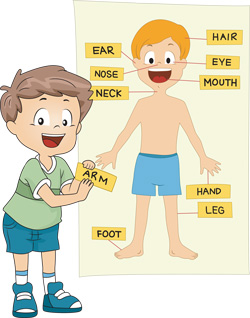
Foot
The foot is the part of the body that is closest to the ground. It is below the ankle. It is the part that you stand on. The foot has the following parts:
- Toes: A foot normally has five toes. These are the little parts that stick out from the main part of the foot.
- Toenails: Each toe has a nail on it. This is the hard surface the covers the top of the nail.
- Arch: The arch is the part of the bottom of the foot that does not make contact with the ground. It is raised.
Ankle
The ankle is the part of the body where the foot and the leg connects.
Leg
The leg connects the feet to the rest of the body; humans have two legs. They are long and thin. The parts of the leg are:
- Shin: The part of the leg that is below the knee and on the front is called the shin.
- Calf: The part of the leg that is below the knee and on the back is called the calf.
- Knee: The knee is the joint that connects the upper part of the leg to the lower part of the leg.
- Thigh: The thigh is the upper part of the leg. It is located between the knee and the rest of the body.
Genitals
The genitals are the sexual organs that are outside of the body.
Hips
The hips are the parts of the body that go from the waist down to the top of the leg on the sides of the body.
Buttocks
The buttocks are located above the legs on the back of the body. They are round and soft. You sit on your buttocks. Another, more casual, term for "buttocks" is "butt."
Abdomen
The abdomen is located on the front of the body. It is above the genitals and below the chest.
Chest
The chest is the part of the body that is on the front, between the abdomen and the neck.
Shoulder
The shoulder is the part of the body where the arm attaches to the main part of the body.
Armpit
The underside of the area where the arm attaches to the shoulder is called the armpit.
Arm
The arm is the part of the body that is long and skinny and extends from each shoulder. The parts of the arm include:
- Upper arm: The upper arm is the part of the arm that goes from the shoulder to the elbow.
- Elbow: The elbow is the joint in the middle of the arm.
- Forearm: The forearm is the part of the arm that goes from the elbow to the wrist.
- Wrist: The wrist is the joint that connects the hand to the arm.
- Hand: The hand is the part of the body at the end of the arm. The parts of the hand include:
- Palm: The palm is the underside of the hand between the fingers and the wrist.
- Thumb: The thumb is the finger that is at the end of the hand and is shorter than the others fingers and can face the other fingers.
- Knuckle: All of the joints of the fingers are called knuckles.
- Fingernails: The hard surface on the top of each finger is called a nail.
- Pinkie finger (or little finger): the finger farthest away from the thumb is called the pinkie finger.
- Ring finger: the finger between the pinkie finger and middle finger is called the ring finger.
- Middle finger: The finger in the middle, which is usually the longest finger, is called the middle finger.
- Index finger (or pointer finger): the finger closet to the thumb is called the index finger.
- Finger tip: the end of the finger farthest away from the palm is called the finger tip.
- Fist: When the hand is curled up, this is called a fist.
Back
The part of the body that is on the back and extends from the buttocks to the neck is called the back.
Neck
The part of the body that connects the head to the shoulders is called the neck.
Head
The part of the body that is above the neck is called the head.
Face
The part of the body with the eyes, nose, and mouth is called the face.
Jaw
The part of the body at the bottom front of the head is called the jaw.
Chin
The bottom center of the face is called the chin.
Ears
The parts of the head that stick out on each side and are used to hear are called the ears.
Cheek
The parts of the face beneath the eyes are called the cheeks.
Cheekbone
The hard area of the cheek is called the cheekbone.
Mouth
The part of the face that opens to let air out and food in is called the mouth.
Teeth
The hard, white surfaces inside the mouth are the teeth. They are used to chew food and to speak.
Tongue
The pink part of the inside of the mouth that moves and is used for speaking and tasting is called the tongue.
Nose
The part of the face with two holes to let air in and out is called the nose.
Nostril
The holes at the bottom of the nose are called the nostrils.
Eyes
The two things that you use to see with are called your eyes. The parts of the eye include:
- Tear duct: the part of the eye that produces tears is called the tear duct.
- Pupil: The central part of the eye that is black is called the pupil.
- Retina: The retina is the part of the eye at the back that sends messages to the brain.
- Cornea: The cornea is the layer that covers the eye. It is transparent.
- Iris: The part of the eye that is round and colored (usually brown, blue, green, or hazel) is called the iris.
- Lens: The part of the eye that is behind the pupil and focuses light is called the lens.
Eyelid
The skin covering the eye that moves up and down is called the eyelid.
Eyelashes
The eyelashes are the hairs that connect to the top and the bottom of the eye. They keep dirt out of the eyes.
Eyebrows
The hair located above the eyes is called the eyebrow.
Forehead
The part of the face that is above the eyes is called the forehead.
The Circulatory System
In order for the body to work properly, blood has to move around the body. This movement is called circulation. The system that makes it possible for blood to move around the body is called the circulatory system. The parts of the circulatory system include:
Heart
The heart is a muscle in the chest. It is a pump. It pumps blood around the body. The heart has four chambers.
Blood vessel
The tubes that move blood around the body are called blood vessels. There are two main kinds of blood vessels:
- Arteries: the arteries move blood away from the heart.
- Veins: veins move blood to the heart.
Blood
Blood is the liquid that flows through the circulatory system. The main components of blood are:
- Plasma: Plasma is the liquid part of blood. It is a mix of many different things.
- Red blood cells: Red blood cells are round and flat.
- White blood cells: White blood cells have the job of protecting the body from infection.
- Platelets: The platelets are small pieces of cells that help blood to clot.
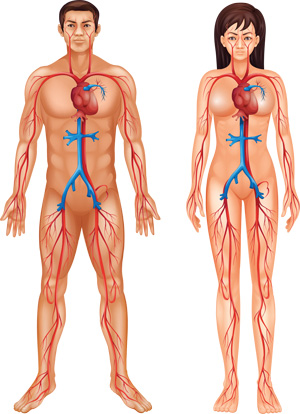
The Respiratory System
You cannot remain alive if you do not get oxygen into your body. And you cannot stay alive if you cannot get carbon dioxide out of your cells. The job of the respiratory system is to get air into the small parts of the body called cells and to take away the carbon dioxide.
The respiratory system works with the circulatory system to make this possible. The respiratory system includes the nose and mouth since we use the nose and/or the mouth to get air into the body. The main parts of the respiratory system are:
Throat
The throat is a tube that lets air move from the nose and mouth down to the lungs.
Lungs
The lungs are two organs in the chest. They are used to make it possible to breathe. There are muscles around the lungs that push them inward and outward. This forces air into and out of the lungs. From the lungs, air enters and exits from the blood vessels.
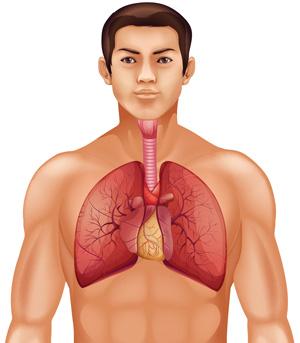
The Digestive System
You can survive a few days, maybe even a few weeks without eating, but your body functions best when it gets enough food. It is the digestive system that processes the food in order for your body to be able to use it.
The digestive system begins in the mouth. Food is placed in the mouth and then the tongue, teeth, and saliva begin to break the food down. The main parts of the digestive system include:
Salivary glands
The salivary glands produce liquid in the mouth. This liquid mixes with the food and turns it into a paste so that you can swallow it. It also begins to break down the food.
Esophagus
The esophagus is a tube that runs from the mouth to the stomach. Food goes down this tube.
Stomach
The stomach is a pouch that stores food and starts to break it down. It also kills bacteria in the food so that you will not get sick.
Small Intestine
The small intestine is a long tube that is not very wide. As food travels through it, nutrients in the food are absorbed through the walls of the small intestine so they can go to the rest of the body.
Large Intestine
The large intestine is a tube that is wider than the small intestines but not as long. Food travels through the large intestine. As it travels, water and vitamins are absorbed through its walls so they can go to the rest of the body.
Liver
The liver is an organ that cleans the blood of toxic substances.
Gallbladder
The gallbladder is attached to the liver. It stores bile.
Pancreas
The pancreas produces a liquid. This liquid helps food be digested.
Anus
The anus is the opening of the digestive system to the outside of the body in the buttocks. After food has been processed in the digestive system, waste products are removed from the body through the anus.
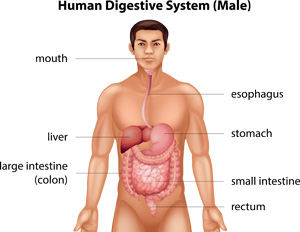
The Excretory System
Your cells produce waste products. If these waste products are not removed from your body, you would get very sick. Plus, there are some parts of foods that you eat that your body cannot use. These are also waste products that have to be removed.
It is the job of the excretory system to remove all of these waste products from the body. We have already talked about the lungs, large intestines and anus; they are part of the excretory system. The other main parts of the excretory system are:
Kidneys
There are two kidneys. They are located in the abdomen. They filter blood and urine.
Bladder
The bladder is a sack in the abdomen that holds urine until it is removed from the body.
Urethra
The urethra is a tube that moves urine out of the body.
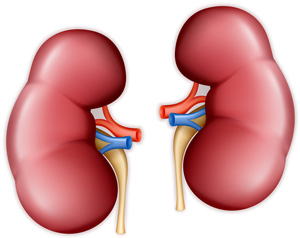
The Nervous System
The job of the nervous system is to carry electrical messages throughout your body. If you feel pain, or if something feels cold, it is because the nervous system sent a signal to your brain to give you that information.
Brain
The brain is a large organ. It is located inside the head. It controls thoughts, movements, and memories.
Spinal Cord
The spine is the group of bones that connects down the back. The spinal cord is a group of nerves inside the spine that sends messages to and from the brain.
Nerves
A nerve is a long, thin thread that carries a message from one part of the body to the brain, or from the brain to another part of the body.
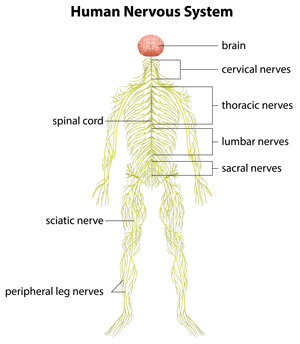
The Endocrine System
The endocrine system is responsible for hormones in the body. Hormones are chemicals that cause growth or some other action in a part of the body. The job of the endocrine system is to keep hormones at the right levels so that the body can be healthy.
Hormone
A hormone is a chemical that the body releases. The hormone causes something to happen in the body.
Pineal Gland
The pineal gland is located in the brain. It releases hormones.
Hypothalamus
The hypothalamus is located in the brain. Its job is to control the body's temperature, release hormones, and regulate hunger.
Pituitary Gland
The pituitary gland is located in the brain. It releases hormones. The hormones that it releases are responsible for the growth of the body.
Thyroid
The thyroid is located in the neck at the front. It releases hormones; these hormones control various functions in the body.
Thymus
The thymus is located in the neck. Its job is to help the body fight infection.
Pancreas
The pancreas can also be considered part of the digestive system. It is located in the abdomen. It releases a liquid that helps the body digest food.
Adrenal Gland
The adrenal glands are found above the kidneys. They produce hormones.
Ovary
The ovaries are the part of a woman's body that produce eggs. They also regulate hormone levels.
Testes
The testes are the part of the male body that produce sperm and regulate hormone levels.
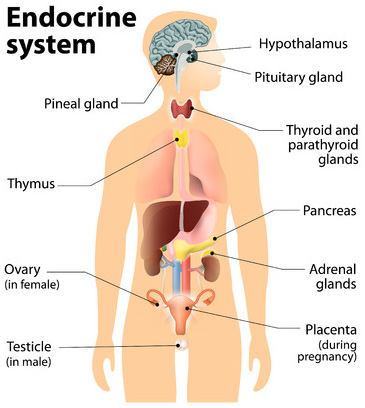
The Skeletal System
The skeletal system is made of all of the bones of the human body. Without bones, it would be impossible to do anything. And if you have ever broken a bone, you know that it makes it difficult to do normal activities when even one bone cannot be used.
The teeth are part of the skeletal system, even though most people do not think of them as bones, but they are. A person normally has 206 bones. These are the main parts of the skeletal system:
Skull
The skull is composed of the bones that form the head.
Ribs
The ribs are the bones that surround the back and chest.
Humerus
The bone in the upper arm is called the humerus.
Radius and Ulna
The lower part of the arm has two bones: these are the radius and the ulna.
Spine
The spine is formed from a series of small bones that go from the buttocks to the head.
Femur
The large bone that extends from the knee upward is called the femur.
Tibia and Fibula
The lower leg is composed of two bones: the tibia and fibula.
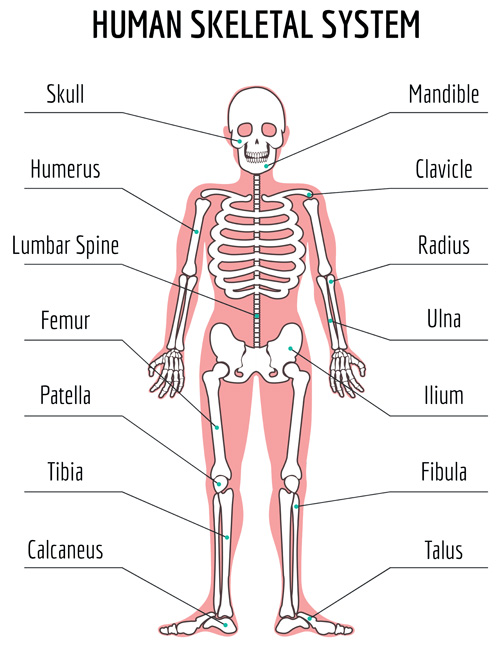
The Muscular System
Without muscles, the bones would not be able to move. Muscles usually work in pairs so that a bone can move in two directions. There are about 700 muscles in the human body. A few of the most commonly mentioned muscles are:
Muscle
A muscle is a piece of tissue that the brain can command to relax or contract in order to move part of the body.
Biceps
The bicep is the main muscle which is found on the arm on the front.
Triceps
The tricep is located on the arm, on the top part in the back.
Deltoids
The deltoids are the muscles that cover the shoulders.
Abdominals
The muscles that cover the abdomen are called the abdominals.
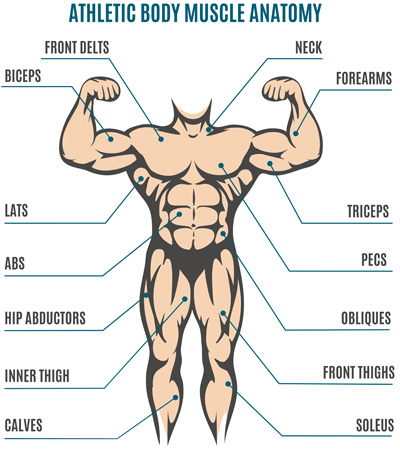
Get Updates, Special Offers, and English Resources
Download your FREE GIFT (the first two chapters of
English Short Stories Book and Workbook)
as soon as you join!

By submitting your email, you consent to receiving updates and newsletters from us and to the sharing of your personal data with third parties for the purposes of sending you communications. We will not spam you. You can unsubscribe at any time. For more information, please see our privacy policy.
Return from Parts of the Body in English to English Vocabulary Word Lists (Illustrated)





